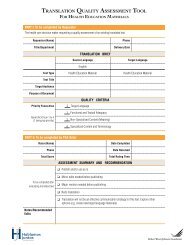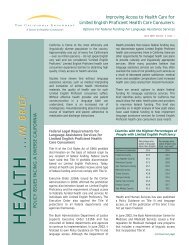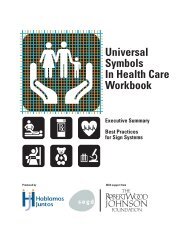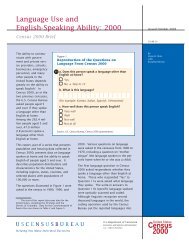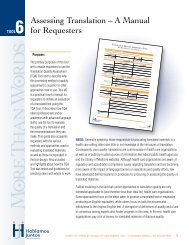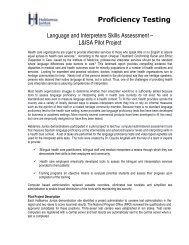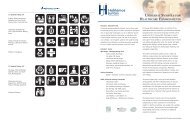Wayfinding chapter 4-7 - Hablamos Juntos
Wayfinding chapter 4-7 - Hablamos Juntos
Wayfinding chapter 4-7 - Hablamos Juntos
Create successful ePaper yourself
Turn your PDF publications into a flip-book with our unique Google optimized e-Paper software.
Fig 1 Shanghai International AirportFig 2 Atlanta Hartsfield InternationalAirport, Apple Design, Inc., based ona template by Osgood AssociatesFig 3 Salt Lake City Olympic banners,Look of the Games, Salt Lake CityCommittee and Infinite ScaleInternational events have encouraged thecreation of a creative pictorial languagethat can also serve to brand the event.06 Symbols and universal designLance Wyman and Craig BergerThe character and effectiveness of any wayfinding system are in largepart a result of the language used to present identity, directional, andinterpretive messages. The visual messages of a wayfinding systemare usually 2-D and/or 3-D representative words and images. Wordscan be from one or more specific languages in a wide variety oftypefaces. Image options range from elaborate, such as pictorialillustrations and photography, to simple, such as color-coding andsymbols. Symbols can contribute simplicity, clarity, and personalityto a wayfinding system.There are two basic ways we have to communicate the objects,actions, and feelings in our lives: sounds (words), and images(symbols). Words are an effective way of communicating complicated,interrelated ideas where symbols fail. It is symbols, however, thatcommunicate across the barriers created by different word languages.As obvious as that might sound, designers too often overlook symbolswhen planning and designing a wayfinding system. Symbols areactually the essential shorthand behind any environmental graphicdesign project. Arrows are symbols that have gained the status ofuniversally understood wayfinding vocabulary. Letters and numbersare also symbols that can be used to represent places and spacesas images that range from literal photographs to completelyabstracted images.One of the most important things to understand before designing orutilizing symbols is the terminology involved in symbol design. Symbolshave specific meanings, and are conveyed specifically. A symbolvocabulary is included at the end of this <strong>chapter</strong> to help you understandthe recognized terminology.A short historySymbols have a history that predates the written word, and oftenform our first understanding of the ancient world. In antiquity, symbolswere used extensively, with ancient Egypt and Babylon usingpictograms to convey extensive written information. With the inventionof written language, symbols began to serve a new role, as a wayto bridge language barriers and assist a largely illiterate population.With the rise in literacy around the world, symbol design and usein signs declined.After WWII, symbols began to make a major comeback becauseof increased globalization. A number of government organizationsbegan to develop symbol standards, first seen in airports, train stations,and highway projects. The U.S. Department of Transportation (DOT)developed a symbols template for transportation in 1974; this is nowthe standard in airports around the world, and used on traffic signs,and in most transportation facilities.With the Olympic Games and other international events, symbols alsoplayed an enormous role in communicating information to a varietyof multilingual groups, and today, with multilingual legislation in everycountry, symbols are often used in institutions to break through thecacophony of languages.Symbol use has also increased significantly with the developmentof the graphic computer and the Internet. Early experimental workat Xerox used visual symbols as part of the language needed tonavigate a computer; the Apple Macintosh relied even further onicons. Today, these early forays into using symbolic language asa guide for users have become standards in computer wayfinding.Symbols help make wayfinding in both the virtual environment of thecomputer world and the real world of our built environments easierto understand and to navigate.When symbols don’t workEvery visual message of a wayfinding system has to communicate on itsown, without the luxury of being explained by the planner or designer.Sometimes, however, symbol systems can fail to make a wayfindingsystem work effectively. Ask yourself the following questions.Are there too many symbols? One of the most common mistakesdesigners make is to use too many symbols. For color coding, the rule ofSymbols and universal design 5732
Fig 4 New York City Subway standards,Calori & Vanden-Eynden DesignConsultants, based on a template createdby Massimo Vignelli A combination ofletters, colors, and shapes can create itsown language, especially for people whouse the system every day.Fig 5 Atlantic City Bus Station signThe creation of a standard set ofinternational symbols for transportationhas effectively created the first trulyinternational pictogram language.Fig 6 LA Walks map, Corbin Design withHunt Design58 Symbols and universal designthumb is to use no more than six colors (e.g., red, blue, yellow, green,orange, and purple); any more causes confusion. It is harder torecommend a maximum number of symbols; even one symbol is toomany if it doesn’t communicate well. On the other hand, hundreds ofsymbols can work effectively if they are well designed and used properly.On road signs, the driver must read while in motion, and withoutslowing down. Here, the use of symbols should be limited to as few aspossible—no more than three or four per sign. Sometimes road signsuse words in combination with symbols, but symbols usually have abetter chance of communicating to the larger audience—if everyoneunderstands the meaning of the symbols.Because subway lines are usually named or numbered and colorcoded,it is possible to incorporate more symbols on subway maps toidentify stations and uses. System maps and station signs are alsoavailable to help. The background shape of a symbol image can helpthe user interpret the message. When the user is standing still, moretime can be allotted to understanding what is meant, so more symbolscan be incorporated into a sign or other wayfinding component.Are the symbols easy to remember? Whether incorporating manysymbols or just a few, use familiar images: they are easier tounderstand and to remember. Use symbols from an established systemwhen possible; for example, the Department of Transportation (DOT)symbol signs (see John F. Kennedy Airport case study on p 65) can beused to represent generic services, activities, and regulations.If the symbols are site-specific, such as identity symbols for districts,events, or special services, design or choose symbols that can bedescribed in any language. A tree image, for example, can bedescribed as “tree” in English, “arbol” in Spanish, and “ki” inJapanese—and has the same meaning in each language. Making surethere is a readily identifiable word for the symbol is important not onlybecause it helps users remember the symbols, but also because theycan describe them when giving directions verbally. If the symbols arearbitrary images, how will the user know which symbol refers to whichdistrict or place?When navigating the urban environment, we often use architecturalstructures as landmarks. Thus, symbols that use architectural images canbe used to effectively identify geographical districts or specificlocations. Landscape elements, such as fountains, gardens, bridges,or monuments, also make good symbol images, as do symbols thatrepresent functions, activities, history, and culture.It is a good rule of thumb to use no more than one similar type ofsymbol image in a given wayfinding system. If it is necessary to usemore than one architectural image, for example, make sure that youemphasize the differences between the building types or add detailsto make the symbols readily identifiable and easily distinguished.Can the user read the symbols? When evaluating the legibility ofa symbol, consider both how familiar the symbol is and how well it canbe seen. Symbols tend to be highly familiar when they are commonlyrecognizable generic images, but there may be a learning curve inconnecting the image with the intended message. Consider all possibleinferences when selecting a symbol to avoid any confusion between theimage and its intended meaning.The visibility and legibility of a symbol depends on a number of factors,including form, size, viewing distance, lighting, color, and contrast.The criteria used in evaluating a symbol’s visibility are very similar tothose for evaluating the legibility of typography, but keep in mind thatsymbols are generally more complicated than simple letterforms,which are immediately recognizable and communicate their meaningwithout needing to be translated. When a symbol is reduced it canlose its clarity; details become blurred. Unless the shape is clearlydistinguishable, one symbol can be confused with another. Highlylegible symbols are simple and direct. Symbols that are toocomplicated to be recognizable or too simple to have meaningbecome decoration rather than communication.Do the symbols say the right thing in the right way? As with words,symbols can express messages with many levels of meaning. They canidentify, direct, and inform with clarity. As with names and writtenmessages, it is important to craft symbol messages to get maximumvalue and effectiveness.Symbols offer designers an opportunity to plan and implementa wayfinding system that visually expresses and supports its uniquelocation, history, and culture. Planners can design or select symbols thatmake the wayfinding system more cohesive, more closely related to itshistory and environment, and unique. But in the end, the symbol mustwork easily for the user. A clever design is not clever if it does notcommunicate to the user.Recommendations for symbol designThere are three schools of thought regarding symbol design andimplementation on projects. While designers tend to fall into one ofthese three camps in their practice, most adapt their approach tospecific projects.Symbols as language One school of thought, proposed by a numberof designers and researchers, is that symbols are a language that canbe learned like any other language, through education and constantuse. These designers have worked to develop sets of standard symbolsSymbols and universal design 59654
Figs 14 and 15 <strong>Hablamos</strong> <strong>Juntos</strong> symbolsresearch project, JRC DesignMexico City 1968 Olympic Games andthe Mexico City Subway Lance Wyman Ltd.62 Symbols and universal design14 An increase in recognition for a group of symbols. This involveslooking at a range of symbols at the same time to see if the viewerunderstands the underlying symbol system. Testing for recognitionoften includes matching a series of symbols with a series ofdestinations. An increase in detection or salience of the symbols in the wayfindingenvironment when additional issues like background, size, contrast,lighting, color, and design are added. Testing for symbol successin detection involves designing a symbol as part of a completewayfinding environment and testing user reactions when navigatingthe system. Recently, a project developed for <strong>Hablamos</strong> <strong>Juntos</strong> and sponsoredby the Robert Wood Johnson Foundation tested symbols designedby a group led by JRC Design for use in the health-care environment.Using the methods illustrated by Wendy Olmstead, the design groupwill attempt to create a symbol language for use specifically in thehealth-care environment.15The philosophy behind these projects was based on the designapproach. The Olympic Games of ancient Greece were one of thefirst events for which symbols were used to represent activities, witha vocabulary of bodies performing different activities. With the firstmodern Olympic Games in 1896, the symbol language begun inancient times was put to a new use: to convey information on thevarious Olympic sports to a multilingual, worldwide audience.An increasingly stylized universal symbol approach was developedfor the Olympic symbols in successive Games.The 1968 Mexico City Olympics significantly changed the designapproach to the symbols by creating a series of graphic forms basedon “glyphs” from Native American artwork. Instead of utilizing entirebodies, the symbols looked to identify activities through elements thatwould have universal recognition and forms that could be utilized indifferent ways. Boxing, in this case, could be represented by a gloveinstead of a boxer in motion, while a swimmer could be representedby a simple arm stoke instead of an entire swimming body.The result of this design flexibility is a symbol system that could also beused as a decorative pattern, integrated into print programs, or usedas part of a large-scale identity program.The glyphic approach utilized for the Olympics was also put to workfor the Mexico City Metro system, which was completed a yearlater. Instead of using human activities as the basis of the system,geographic and cultural references were used to define a sense ofplace for each train station. Because the Metro system would be in usefor much longer than one event, the symbols were designed to makereference to specific urban places. The symbols were also configuredto be the dominant design element over text and number information.Linear station maps of symbols created strong approaches forreferencing symbol information, by showing all the symbols in context.16 17Symbols and universal design 63Fig 16 Native American glyphs used in a contemporary Huichol wool painting.Fig 17 Olympic symbols based on glyphic images, Lance Wyman Ltd., with Beatrice Coleand students from the Ibero-Americana University
64 Symbols and universal design1819 2021John F. Kennedy Airport, Teminal 4Chermayeff & Geismar, based on graphic standards by Bureau MijksenaarThe philosophy behind this project was based on the designvocabulary approach. International airports have been among the mostmultilingual environments of all building types. The average internationalairport has people from 30 countries in it at any one time. In thisenvironment, standard symbols, text, and color are important to conveyvisual information. Governmental organizations have been conscious ofthis issue for some time. Their attempts to develop standards culminatedin the U.S. Department of Transportation (DOT) symbol standards,sponsored by the American Institute of Graphics Arts (AIGA), anddesigned by a team including Massimo Vignelli and Thomas Geismar,in 1974. Fifty symbols were created and tested. Over the years, thesesymbols were integrated into thousands of different transportationprojects, from train and bus stations to highway projects.In an attempt to develop a complete international airport standard,Bureau Mijksenaar in Amsterdam developed standards that integratedthe DOT symbols as a vocabulary, along with color, type, and lightingstandards. This system has been used in airports around the world,including Amsterdam, the Netherlands; Baltimore, Maryland; andColumbus, Ohio.22 22Symbols and universal design 65This system is currently being utilized at the New York Port AuthoritiesAirport System. The three airports of John F. Kennedy, Newark Liberty,and LaGuardia operate separately, as do all individual terminals.Over the years, this has resulted in a vast variety of signage styles andtypes, with inconsistent—sometimes even conflicting—information, alldisplayed in an already highly complex environment. The challengewas to develop one master system that could be applied to all airportterminals, roadways, and parking facilities, and that was sophisticatedenough to direct passengers from all over the world within anenvironment of hundreds of possible destinations.Instead of a system that relies completely on symbols to expressinformation, the standards work on a number of levels and do not relyon any one element for wayfinding. Instead of having visitors rely overlyon the symbols as a system, the standards are integrated with a green,yellow, and black color palette as well as text and arrow standards.The final configuration integrates the symbols palette as anotherlanguage element along with text and color.This systems approach has proven to be very popular. In testing byJ. D. Power and Associates, airport users have reported easier airportnavigation and comfort with the new wayfinding system.Fig 18 Mexico City Olympic sign, Lance Wyman Ltd. with Peter MurdochFigs 22 and 23 A green, black, and yellow color palette was selected for the signage.Figs 19 and 20 Mexico City Metro symbols, Lance Wyman Ltd. with Arturo Quinionesand Francisco GallardoFig 21 Mexico City Metro sign, Lance Wyman Ltd.
66 Symbols and universal designThe language ofsymbol design Glyphic language A symbol based on an ornamental design.Used extensively in language by Egyptions, Greeks, and NativeAmerican tribes Logos Corporate brands and icons used as symbol information Symbol understanding Being able to define a specific symbol Discrimination Being able to differentiate symbols from each other Recognition Being able to recognize a specific symbol amonga group of symbols Detection Being able to read a symbol as part of a sign or document Referent The meaning of a symbol Symbol standardization Attempt to create a specific symbolvocabulary that can be used in a variety of situations liketransportation and health care Direct symbol A symbol that represents some aspect of what is beingpresented; for example, a picture of a snail representing slowness Indirect symbol A symbol that stands for an object other than what itappears to be representing, for example, an elephant representingthe Republican Party Universal symbol A symbol that can be understood by almost allusers around the world Unique symbol A symbol meant to be used in only one specificproject Pictogram A symbol that uses the representation of a material objectto convey meaning Abstract symbol A symbol that at one time represented a picture,but that has been abstracted into symbolic indications over the years,for example, arrowsSymbol designrecommendations Do not design too many symbols for a project. Symbols are alanguage and too many characters make it more difficult to learn. Use familiar images for symbols. Use symbol standards and conventions wherever possible, but makesure to integrate them into the overall design of the project, includingmatching colors, shapes, and sizes. Symbols should look similar enough to each other to look like theyare from the same family, but not so similar that they cannot bedifferentiated from one another. Keep symbols simple to ensure legibility in the environment. Numbers and letters can be used as effective symbols. They canalso be integrated with unique symbol languages. Symbols are more effective with additional support from print,maps, and text. Symbols can convey unique places and personalities, but theirparamount goal is communication. Unique symbols should be looked at in terms of design flexibility—how they can be integrated into patterns and other decorativeelements.Fig 24 ING Direct Store, GenslerSign systems can succeed using a hybrid of well-knownstandard symbols and unique symbols. Arbitrary symbol A symbol that does not represent a specific object,for example, numbers, letters, musical notes, and mathematical signs Silhouetted pictorial Symbol represented as a direct symbol in onecolor on a black background, needing no learning process tounderstand, for example, park symbols Diagrammed pictorial Complex symbol that is not immediatelyunderstood, but takes time to learn, for example, a city’s coat of arms
Implementation and projects—internal07 Transport systems 7008 Health-care facilities 8409 Corporate environments 9810 Museums and exhibitions 108
Fig 1 Reading Station, Philadelphia, U.S.A.The railway stations of the late nineteenthcentury used very consistent architecturaltools to define how people approached,purchased tickets, and went to their train.Fig 2 TWA Terminal at John F. KennedyAirport, Eero Saarinen Architects With thejet age, transportation buildings took onfree-flowing, non-traditional forms.Fig 3 Los Angeles MetropolitanTransportation Authority (MTA),Hunt Design Transportation graphicsare becoming the glue that binds vasttransit networks.07 Transport systemsEllen Taylor AIAIn transportation work, wayfinding is usually a four-letter word that startswith “s”: sign. While signage may affect the design of any project, intransportation projects user-friendly signs are a critical component thatoften gets overlooked or is intentionally ignored by architects, planners,or transportation engineers. The people working on the project maythink that a good design does not require signs, or feel that signs willvisually clutter the quality of the design. However, if the design teamdoes not address the signage issues in a building, someone else will,and the result will probably not reflect the vision for the building. Thishaphazard or belated approach to signage and wayfinding programscan result in an unattractive and ineffective addition to even the mostbeautifully designed structure. We have all seen messages scribbled onpaper and taped to a window or door. The architect is not thereeveryday, but the station manager and janitors are. If you do not wantothers to make decisions that affect the appearance of the places youdesign, plan for signage, graphics, and information systems in advance.Environmental graphics can address several aspects of wayfinding inthe design and use of a building, but in transportation, environmentalgraphics has multiple roles. When properly designed, the graphicsserve to inform without confusion. The graphics must do this while at thesame time creating a consistency and balance in design. To functioneffectively, the graphics must neither overpower nor get lost in the otheraspects of the fit-out. Travel can be stressful for many people, and theuse of environmental graphics, along with good architectural design,can have a significant impact on creating a positive experience fortravelers. Two areas that are especially critical in transportation projectsare identity management and wayfinding through directional signage.A short historyIdentity and wayfinding have been critical issues since the birth ofmodern travel at the end of the nineteenth century, and the rise ofmodern rail networks. At that time, train stations were built so that thearchitectural design would inform people about where to find theirtrains with minimal additional support. The stations were all formallydesigned with a processional front door or head house backing intoa large bay of trains. Ticketing and other features were placed insimilar locations in every station. The train user knew the system well.This architectural, ritualized approach to wayfinding began to breakdown in the early twentieth century. Instead of servicing a singlecompany, train stations became integrated into vast urban networkscontaining regional trains, long-distance lines, and urban metro systems.Architecture began to play a secondary role to graphics in identifyingwhere users were and how they could navigate the system. At the sametime, the stations themselves began appearing as single and multiplebuildings as well as aboveground and underground, further diluting thearchitectural hierarchy that made wayfinding self-evident.In addition, modern air travel began to dictate the spread of largeairports, each containing dozens of different airlines and terminals.No formal architectural hierarchy was developed for airportarchitecture, with the result that terminals began to take on uniquefeatures and layouts. This meant the traveler lost all naturalunderstanding of their environment, which thus had to be supportedwith an alternate system carried by graphics and signs. Furthermore,the ownership and control of transportation systems were often spreadamong local and regional networks for train stations and airlines, andmunicipal authorities for airports.Primary issues in transportation wayfindingThe wayfinding aspects of environmental graphic design cannotbe underestimated, as many travelers are new or infrequent usersof a transportation system, and often visitors to the area. Users relyon directional signage to help them through their journey. Effectivewayfinding signage is truly an art form that requires a great dealof experience and skill in presenting information, and a realunderstanding of how information is digested. The five key areas forconsideration are outlined below.Acknowledgment Architects should have a basic understanding of howsignage standards, design, and fabrication work to create an effectiveproject. Without a basic understanding of these issues, there is potentialTransport systems 71321
Figs 4–6 Amtrak sign system, Calori &Vanden-Eynden Design ConsultantsDesign standards are crucial to the successof modern transportation systems, byproviding a consistent template for color,type, and form, and using it to extend thesystem brand across a wide variety ofdifferent locations and uses.Fig 7 Newark International Airport, AppleDesign Inc., based on a design templatedeveloped by Bureau MijksenaarBecause of the complexity of airports andrailway stations, numbers, letters, andsymbols become key methods foridentifying terminals and services.Fig 8 Miami International Airport, CarterBurgess Architects Designing a largenumber of different sign types to distributeconsistent information instead of loadingall information on a single sign is crucialto project success.72 Transport systemsfor dissatisfied clients, as well as frustrated and unhappy users. Mosttransportation providers have developed standards for wayfindingdesign. The standards in transportation projects identify types ofsignage and placement, as well as the graphic components, such asspecific colors and fonts. Standards are critical because they representthe client’s identity, as well as an approved approach to functionallyrelaying information. These standards can be a valuable part of thedesign process.When acknowledged and incorporated early in the process, theidentity and graphic standards can facilitate a stronger building design.It is therefore very important for the architect to ask for and receive anyand all design standards that are in use or under development by anydepartment within the transit organization. Of course, the signagesystem also needs to comply with local and national legal requirements,which may dictate fonts, contrast, and placement.Hierarchy One of the most colorful quotes about transportation signagereferenced New York’s airports. The airports were referred to as“emotionally wrenching portals into the New York state of mind—theone that says, ‘Sink or swim, baby’.” Part of this reaction came from theinadequate signage system. A marketing survey conducted by the PortAuthority of New York/New Jersey revealed that confusing airportsignage ranked second to dirty restrooms in travelers’ complaints.What frequently happens in complex environments—whether a trainstation, airport, hospital, or city—is that over time, rather than replacingincorrect signage, new signs are added to the old ones. This results ina system that lacks any cohesive qualities for hierarchy.At Kennedy Airport, for example, there was no directional signage toManhattan. Signs for the Van Wyck Expressway were prevalent, butthe first reference to Manhattan was at the Midtown Tunnel—not helpfulwayfinding for first-time or occasional visitors trying to find their way todowntown New York. Furthermore, parking garages lacked informationabout which terminal the garage was serving, leaving you on yourown to figure it out.The hierarchy of a message system is important. An effectivewayfinding system identifies the major elements first and follows upwith specific details, such as building identification, entrances,ticketing, waiting, and boarding.The New York Port Authority uses color-coding to provide additionallevels in the hierarchy. Black letters on a yellow background(traditional warning colors) direct departing passengers; white letterson a green background (natural colors/highway signage) directspassengers leaving the airport; and yellow letters on a dark graybackground directs passengers to waiting functions and amenities.This new system allows users to focus only on signs that use the colorsassociated with their leg of travel and ignore other information, therebyreducing the amount of information that needs to be scanned anddigested. The defined methodology can also help to reduce the numberof signs needed and provide a streamlined design, resulting in far lessclutter, more attractive building, and an environment that is far moreeasily navigated.Quantity As we have seen, less can be more when it comes todirectional and wayfinding signage. A glance at Union Station inWashington, D.C., highlights the potential pitfalls of providing toomuch information. Multiple signs with up to 12 messages each areplaced at regular intervals along the main circulation spine of the railportion of the station. Furthermore, the same information is at differentlocations on each sign and there is no coordination of directionalarrows or hierarchy of information.Creating a new plan at Union Station raised all of the difficult questionsassociated with designing and implementing wayfinding signs in anarchitecturally open facility, or one with multiple entrances, as are foundin most transit environments. The solution required considering the user’sperspective and focusing on the sequence of the journey from variousentrances. The resulting wayfinding system highlights ticketing, waitingfunctions (including retail), and boarding location information; lessimportant and duplicate information was eliminated in order to reduceinformation overload. Text and pictograms are used to address theuser’s immediate needs. Each sign has a maximum of three messagesand a “preview bar” that lists upcoming functions and amenities.As the traveler moves through the station, the new wayfinding systemthus clearly provides the needed information in an organized andeasily digested way.Legibility Many architects want signage systems that become almost aninvisible part of the building’s architecture. This may be appropriate forcertain building types, but in transportation, the key aspect of signageis legibility and visibility. The information that the travelers require muststand out and be easily recognizable. Signage that is consistent withthe architecture may be attractive, but it may also be completelyineffective as communication. For example, the main train informationboard in Washington, D.C. was designed to become part of thecentral retail component in the grand entrance hall. The shape of theboard matches the architecture, and the cherry stain of the woodcreates a common tonality with the dark colors and lighted informationsystems on the information board. The result is low visibility: almosteveryone entering the station misses the signage. This signboard lookswonderful and does a great job complementing the architecture, but itfails in meeting its main objective of providing information for the traveler.Transport systems 7387654
Fig 9 New Jersey Transit Station directionalsignage.Fig 10 Union Station, Washington, D.C.High technology and beautiful detailingdoes not always equal visibility.Fig 11 Schedule board, 30th StreetStation, Philadelphia, PennsylvaniaTravelers love familiarity and tradition.The old-fashioned schedule board can bereplaced with electronic information,but the clicking caused by schedulechanges comforts the visitor and drawsattention to the object. In comparison toUnion Station, this sign provides visibilityby engaging the ear as well as the eye.Fig 12 Grand Central Station retail sign,Two Twelve Design Associates74 Transport systemsSupplemental components Supplemental components, such asadvertising or retail signage and promotional signage, are integralaspects of a transportation facility. For an architect, the charge is tohelp the client identify standardized sizes and lighting levels. The valueof a message can be greatly enhanced through the consistency ofpresentation. When the architect works to accommodate theinformation and communication functions, the resulting solution does notdetract from the architecture, but does accommodate the needs of thetravelers and others using the facility. Some of the requirements toaccommodate information functions may include fixed poster frames,picture rails, or suspended hanging rails. Multiple sizes that arerandomly mounted create a disorganized visual environment. Whenplanned in a cohesive manner, however, the promotional materialsbecome an integral part of the space.Another issue that is difficult to identify in signage standards is lighting.In general, the ambient lighting of a public area is adequate forsignage legibility, but retail stores often rely on eye-catching storefrontdisplays. Be aware of surrounding conditions so that you can determinewhether specific lighting is required to improve the legibility of a sign.Rules of thumb in transportation wayfindingThe five primary issues are addressed more fully through ten rules ofthumb to guide the design of the transportation wayfinding system. Think about what the passenger needs to know at different pointsduring their journey. People involved with transportation projectstravel, but often forget what they need when they are faced withunfamiliar situations; it is always helpful to be “uneducated” in thisregard. Service is improved by providing the right information in theright place at the right time. This is often briefly addressed in typicallocation plans of any standards manual. Think about how people will behave. The location and orientationof information will influence where someone is comfortable standing,sitting, waiting, or queuing. Passenger flow diagrams should bedeveloped between entrances, exits, and major functions tounderstand the critical paths of the facility. The shortest distancebetween two points is a line, and passengers will follow this rule,even when given a more formal path to follow. Information shouldbe included at some of these locations, but should be eliminatedat others to avoid bottlenecks and congestion. Provide the right amount of information. Too much information ona sign creates confusion and results in an ignored informationsystem. A well thought-out message schedule translates into positiveperceptions for the operator and their respective customer service. Use fonts consistently. Most operators will have a sign standardincluding a corporate font for wayfinding (most often sans serif forlegibility). Strive to use only one font type in transportation facilitiesfor clarity. If multiple users are present, a neutral typeface should beincorporated to avoid brand standard clashes, unless the providerscan agree to use one standard or another. Use appropriate materials and colors. Consider the contrast, thelighting, the architecture, and the viewing angles. A sign that blendsinto the architecture becomes useless, and materials such as clearglass become invisible in complex wayfinding environments.Additionally, when designing one terminal or station as part ofa larger service route, it is important to recognize the signage aspart of the operator’s system, not just a design exercise for a standaloneproject. Consistency of materials and colors from station tostation aids a traveler’s understanding and comfort with thewayfinding system throughout their journey. Use appropriate mounting solutions. Sometimes a sign band alonewill not be visible in the context of the architectural layout. Overheadsigns and signposts are often required for adequate visibility. Make sure that the transportation functions can be found.Transportation facilities are often supplemented with retail functionsthat can easily confuse the environment due to lighting, color,displays, and activity levels. Try to establish standards for retail aspart of the project to insure that the transportation information is stilla focus of the facility. Remove clutter. Older facilities become an archeological study ofsign types. New facilities will begin to develop a multitude of signsover time. During any project, make sure the old and/or unusedsigns are removed as part of the demolition process, not just left asan unintentional supplement to a new program. Understand post-occupancy issues. Cleaning, maintenance,replacement, and operations are significant issues. A beautiful signsystem that is too hard to maintain will quickly be overcome byalternatives. Incorporating advanced technology, if the supportstructure does not exist, will create an operational nightmare ofexpensive and unused electronic components. Lastly, help to educate the client and the whole design team aboutthe role of wayfinding. Often this step is overlooked or added latein the process, resulting in ad-hoc systems of signage as the buildingis used over time. The best architectural solutions still need signsin transportation environments. Helping the team understand theimplications of good and bad solutions can improve customerservice and help to avert post-occupancy difficulties.Transport systems 751211109
Fig 13 Sound Transit directionaltrailblazer sign, TubeArt Signs and SportsDisplaysFig 14 John F. Kennedy InternationalAirport, Terminal 4 building identificationsign, Chermayeff & GeismarFig 15 Los Angeles MetropolitanTransportation Authority (MTA) stationidentification sign, HuntDesignFig 16 Washington D.C. Metro Map,Lance Wyman, Ltd. Metro system mapsmust provide complex information in darkand crowded places.76 Transport systemsTypical components for transportation wayfinding programsMany sign types are common to all transportation systems, while othersmay vary according to mode. The following types should beconsidered for a complete wayfinding package.Logo or trailblazers Inexpensive trailblazer signs to put on majorhighways and access routes are important to help passengers find thefacility, whether an airport or rail station.Facility identification Monument signs are an effective way to identifyfacilities and often offer more flexibility in placement and entranceidentification than identification mounted directly on the building.For urban transit and subway systems, this can be as simple asconsistent entrance identification.Parking location signs These signs identify locations to park, dropoff departing passengers, and pick up arriving passengers.Arrival and departure information signs Arrival and departureinformation includes a combination of static, schedule-based print materialand real-time, electronic, variable message systems, whether CRT(cathode-ray tube), LED (light-emitting diode), LCD (liquid crystal display),plasma, or other technology. They may be used in ticketing areas, mainconcourses, at boarding gates, and on platforms, and will vary in sizeand detail of information, based upon the sequence in the journey.Ticketing counter corporate backwall graphics The ticketing counterprovides an opportunity (possibly the only one) for the service operatorto incorporate their own brand and identity standards, especially inmultiple-use facilities.Ticketing counter availability Overhead or counter-mounted signs canindicate whether the position is open, closed, the next available agent,or a special service (i.e. first class, frequent user).Freestanding stanchions Often used in ticketing and security queues,freestanding stanchions can direct passengers to the correct line,as well as provide information about the materials they will needfor the process.Directional signage Sign bands, overhead, wall-mounted, and floormountedsignage should be used to provide directional informationsuitable to the travel sequence. Priorities of information need to beestablished to ensure that the correct information is offered at the correcttime for the passenger’s needs. The directional signage is most oftena combination of text and pictograms. These signs often include serviceidentification as well, such as telephones or rest rooms.Retail signage Although often under the purview of another department,standards for retail operators (sign bands, flag mounts, and storefronts)should be developed to ensure compatibility with the other facility signs.Advertising Third-party advertising contracts are often part oftransportation facilities. Space needs to be provided for standardvertical and horizontal format adverts, which may be in both print andelectronic formats. The effect of large, spectacular-style banners andimmersion campaigns need to be considered, too. When space isdesigned to accommodate these functions (whether through frames,hanging picture rails, or other solutions), they can be better managedand controlled. Speak with the advertising provider to understandstandard sizes used in the industry.Maps Different modes will require different types of maps. Terminals,such as airports and large rail facilities, typically require a plandirectory to highlight major functions, including ticketing, information,retail, rest rooms, waiting, and boarding. Route facilities, such ascommuter rail stations and subways, should provide system maps toidentify route stops and connection locations. System maps are oftenlocated with printed schedule information.City/stop identifiers Rail systems, in particular, require identifiers forthe station location visible to both the waiting passengers and thepassengers arriving on the train. Directional arrows should be includedto orient the passenger to major city locations or neighborhooddestinations (to hospital, to university).Temporary signage frames Frames for temporary signage should beincluded to announce policy changes, scheduled maintenanceimpacting service, and regularly placed marketing materials.Permanent room signage Permanent room signage to meet all codesis required.Regulatory signs Transportation facilities have corporate regulationsand federal regulations that they need to convey, which require suchsigns as “secure area,” “employees only,” “danger,” “caution,” “nosmoking,” etc.Signage design solutionsIn general, three approaches can be used in transportation facilitydesign projects.Design-build approach A design-build scenario, in which one worksdirectly with a fabricator, is often the riskiest approach, but it can becost-effective and provide a timely way to complete small-scaleprojects. Design-build should be used only where the needs are clearlyidentified beforehand and the amount of information to be reviewed ona shop drawing is limited. A fabricator does not always keep in mindthe interest of the client or the architect, so plan to spend extra time andattention reviewing drawings and proposals.Transport systems 77161514
Fig 23 Flow diagram, marking the mainpassenger paths.Fig 24 In the passenger hold rooms at thedeparture gates, large, wall-mounted, cutoutaluminum numbers identify each gate.Horizontally mounted rails underline thesenumbers and carry rows of LEDs to lightthe numbers with a “halo” from below.80 Transport systemsbudgeting with project managers. One of the main ideas that cameout of the research and design investigations was the use of patternsof light for wayfinding. Light was explored as a central theme andillustrated in the master plan, from the nature of light and its phenomenato its practical use in navigation, and the welcoming sight of runwaybeacons at the end of a journey. This idea is manifest within the airport,where points of light (LEDs embedded in posts and rails) are used tomark a path, such as that from the check-in counter to the departuregate, together with washes of light to define gate destinations. In theevening, the lighting is intended to have a calming effect, echoing theinterior cabin lighting of an airplane that comes up as night descends.The theme of light also fits extremely well with the design of the airport.Using light as a wayfinding device would keep the open, airy, andflexible feel of the airport while still allowing the user to pinpoint thewayfinding elements in such large spaces.The environmental graphic design approachBased on the light theme and the extensive master plan, a series ofdesign elements were created in collaboration with architects TerryHeard and Yow Consultants. The main wayfinding object was a uniquesign post and panel system and lighting used throughout the terminalcomplex, including curbside information and regulatory signs, modifiedto support ceiling-mounted signs where required. The key element of thepost and panel system is its flexibility, with the ability to contain its own2324power source, lighting elements, electronic information screens, andother attachments. The sign system was also adapted to createspecialty lighting fixtures, and integrate airport advertising displays andtelephone tables. By allowing one basic object to fulfill all thewayfinding and identity roles in the facility, advertising and other signelements were kept off the building wall and ceilings, keeping thedynamic form of the airport pristine and uncluttered. These objects alsohave the ability to be moved in the airport floor space, allowing theentire airport facility to be quickly reconfigured as needs change.The type and symbol vocabulary also supported the flexibility of thepost objects. Ottawa, like most international airports, is a multilingualfacility, and supports the needs of the international traveler throughstandard pictograms and simple flag forms. Flags distinguish theprincipal destinations of travelers: domestic, international, and U.S.Gottschalk+Ash introduced large arrow icons in red or, for U.S.destinations, in red, white, and blue. These arrows indicate transborder,domestic, and international passenger routes and are installed alongpathways to the specific destinations. The check-in staff at the counteronly need to tell passengers, “Please follow the red arrow.”With so much information being placed on a single sign, the signpanels are based on a modular grid that differentiates primary fromsecondary information to keep information structured and uncluttered.The directional arrows are always placed inside a separate verticalcolor band while text information in English and French is placed on itsown band separated from the universal symbols. This approach allowsthe bands of information to be configured in different ways based onthe informational needs of the sign, while still allowing for oneconsistent sign module.Like railway stations before them, airports are a visible expressionof today’s fast-paced and interconnected global society. The Ottawaairport offers an understated appearance, proportional in scale,filled with natural light, and elegant in the choice of materials andlayout. It is a welcoming sight for the world traveler, supported bya wayfinding system that enhances the architectural integrity of thespace while supporting traveler needs.25Fig 25 The sign support system—comprising post, arms, panels, and hardware—wasengineered and tested to see that it was suitable for a variety of conditions. It carries powerand lighting, and support for a variety of airport information devices, including FlightInformation Display System (FIDS), plasma, and LED displays. The modularity of the systemallows for ease of maintenance and response to the ongoing requirements of the airport.The small, 4 x 6in (10 x 15.25cm) footprint of the signpost helps the wayfinding systememphasize the open structure of the building. The ability to carry a variety of informationreduces visual clutter and keep signs off the actual building structure.Transport systems 81
Transportsystem designrecommendations82 Transport systems2627<strong>Wayfinding</strong> and environmental graphics in transportation, like thearchitecture it supports, involves the ABCs of design: acknowledgment,brand, and customer service. First, the importance of environmental graphics must beacknowledged. If the designer treats signage as an afterthought, theusers will undoubtedly create their own system to address thewayfinding system’s inevitable shortfalls. The result is often lowquality,inconsistent, and ineffective signage posted in too many, toofew, or undesirable locations. Brand is an important component for clients, owners, and operators.The wayfinding project team and clients need to understand andagree on the message that the system is sending about the corporateculture and vision. Even details such as the font used on signs canhave an impact on the message that is sent. Environmental graphics are an integral aspect of customer service.In transportation facilities, there are many transitions between acustomer’s points of contact. A successful graphics programcontinually reassures users that they are in the right place, headed totheir desired destination. Ultimately, effective wayfinding contributesto a more successful building design for the end user.Fig 26 The bilingual signs distinguish English and French messages through the use of plainand italic type. Type sizes and sign panels are both based on a modular grid thatdifferentiates primary from secondary information. The typography of the Ottawa airportsigns establishes a distinct, contemporary identity. The chosen typeface for the wayfindingsystem is Thesis—The Mix, which was designed by Luc DeGroot between 1988 and 1994.It is a modern typeface with substantial range, clarity, and character.Fig 27 Brevity and clarity are the guiding principles for airport communication. Wheneverpossible, standard international pictograms and symbols are used. Flags distinguish theprincipal destinations of travelers: domestic, international, and transborder.



